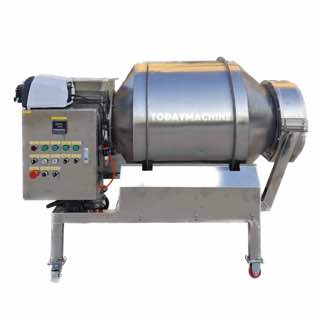2D Motion Blender
The Two-Dimensional Motion Mixer is a blender that moves in two directions: the rotation of its drum and the oscillation of the drum with the frame. This dual movement ensures thorough mixing of materials within a short time, as they rotate, invert, and blend within the drum while also experiencing side-to-side mixing due to the drum’s oscillation.
A dual-motion industrial blender combining rotary drum spinning and horizontal frame oscillation. Materials undergo tumbling inside the drum while simultaneously receiving lateral shear forces, achieving >99% homogeneity in 50% less time vs. single-axis mixers.

Technical specification
| Model | Volume | Max capacity | Voltage | Power | Dimension(mm) | Weight(kg) |
|---|---|---|---|---|---|---|
| EYH-250 | 225L | 60kg | 220V/380V | 1.5kw | 1200*800*1120 | 260 |
| EYH-500 | 485L | 100kg | 220V/380V | 1.8kw | 1600*900*1200 | 850 |
| EYH-800 | 835L | 200kg | 380V | 2.2kw | 2100*1050*1250 | 1300 |
| EYH-1000 | 1085L | 300kg | 380V | 3kw | 2300*1200*1800 | 1500 |
| EYH-2000 | 1990L | 660kg | 380V | 4kw | 2500*1500*2100 | 1700 |
Video
Maintenance Guide
Authorized by: Engineering & Quality Assurance Team
Preventive Schedule
| Task | Frequency | Tools/Materials |
|---|---|---|
| Axis lubrication | 250 hours | NLGI #2 grease (food-grade) |
| Belt tension adjustment | Quarterly | Laser tension meter (≥50N) |
| Blade wear inspection | Monthly | Micrometer (measuring ±0.01mm) |
Common Failures & Solutions
Motion Calibration Errors
Symptom: “Axis Overload” alarm (Error Code E21).
Solution:
Check for mechanical obstruction in X/Y rails.
Recalibrate servo torque limits.
Replace worn ball screw (if backlash >0.1mm).
Fluid Leakage
Symptom: Seal failure around blending vessel.
Solution:
Inspect PTFE gaskets for cracks.
Tighten flange bolts to 25 Nm (torque wrench required).
Upgrade to double-lip seals (P/N: MB-SEAL-2L).
Compliance & Safety
EMC Standards: EN 61000-6-2 (immunity) and EN 61000-6-4 (emissions).
Lockout/Tagout: Follow OSHA 1910.147 during maintenance.